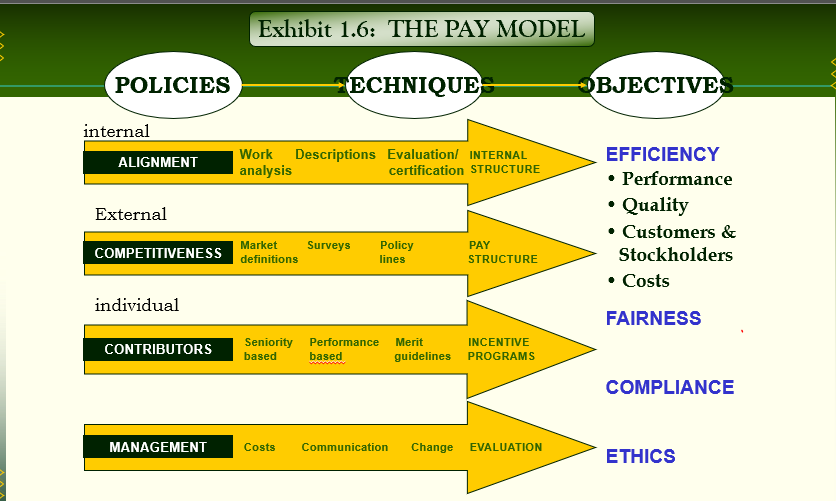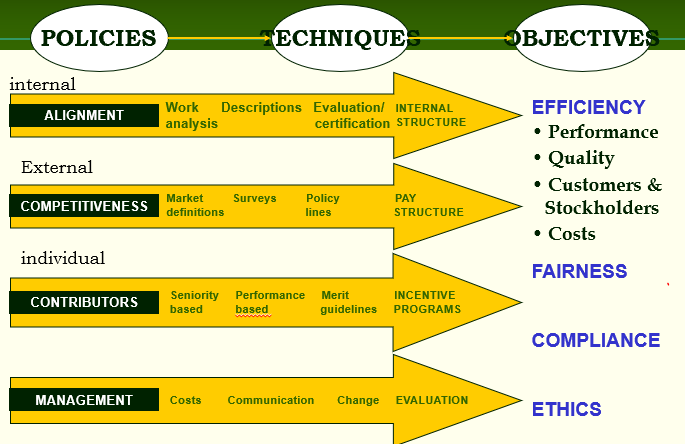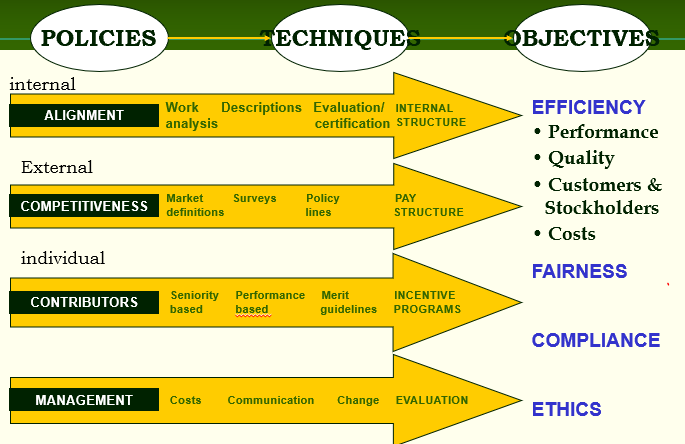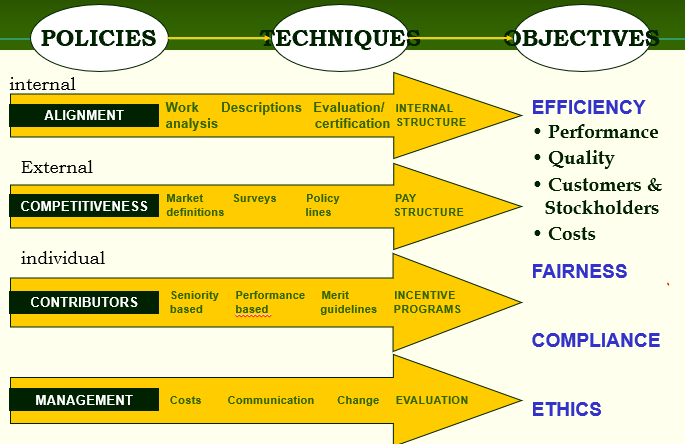First Notes: Fairness: Day 2 Strat Comp
1/21
There's no tags or description
Looks like no tags are added yet.
Name | Mastery | Learn | Test | Matching | Spaced |
|---|
No study sessions yet.
22 Terms
Overview
Use pay fairness discussion to provide overview of course topics (Chap. 1, Part 1)
Intro - Questions? Assignment 1 for next Tues on Canvas
“Are you paid fairly” discussion follow-up - Chap 1—types & forms of returns from work
Understanding pay fairness perceptions—Equity theory (covered in Chap. 3)
Chap 1– Definitions and Pay Model
Are you paid fairly
factors
depend on tips/low base pay
benefits
can’t control pay
subjective criteria
location - remote
amount of skill/effort required
comparison - diff org - similar job
ability to pay
length of stay - experience
value of job, location, flex
job security
Types and forms of returns from work (Chap. 1) “Total Returns” [or ‘Total Rewards’]
Total Compensation (Financial Returns)
Direct: cash (e.g., wages, merit, incentives)
Indirect: Benefits and Services (e.g., insurance, retirement, paid time off)
Relational Forms (Non-financial):
Recognition & Status
Employment Security
Challenging Work
Learning Opportunities
Relationships, support, safety, fairness, etc.
My additional notes
Total compensation – all the things you get financially from work
Relational – valuable and important but not financial
Why are these important: Identifies the things we will be focusing on. There is an understanding that there is some sort of trade off between the two (you may be willing to accept less pay if you have more non monetary benefits.
Helps determine satisfaction – with job, pay, and benefits
Equity Theory Comparisons: people are motivated by perceived inequities
In determining pay fairness people consider the following:
–External comparisons: those doing same job in different organizations
–Internal comparisons: those doing same or different job in same organization
Managing pay fairness perceptions means managing these comparisons
My notes on equity theory
Theories are useful as a model or framework to understand categories of different things and their relations
Equity Theory: How people think about this issue of fairness. A theory of motivation- people are motivated by inequity. “If I am getting paid unfairly, I will do something about it bc I don’t like it”
Thinking about total returns and comparing what I get with external and internal comparisons. Who are we comparing ourselves too? Not gonna compare yourself to the pay that your manager and higher ups get
Understanding Pay Fairness Perceptions: Equity Theory
Fairness perceptions determined (in part) by comparing: Do Outcomes / Inputs [for us] = Outcomes/ Inputs[for other]?
What are important outcomes (returns) from work?
Total Returns
What are the inputs that people bring to the job?
Education
Experience
Ideas
Effort (work ethic)
Ability to Communicate effectively
Performance
notes
Outcomes and inputs. total returns are outcomes. Inputs are all the things we do/bring/provide for work. Inputs: education, experience,
Consequences of perceived inequity
Perceived Inequity:
O/I (person) < O/I (other)
examples: 500/100 < 500/50
Options for restoring equity?
Increase outputs – raise, leave, form a union
Decrease inputs – reduce effort (slow to help coworkers or less responsive to customer needs/picking up phones less)
Interesting options:
increase effort to get attention from boss- this would increase your perceived inequity
Increase efficiency – find hacks so you don’t have to work as hard to maintain the level of inputs
Decrease workload – ask boss to decrease
Limits to theory
Perception: Who is comparison?
Individual differences in responses to perceived inequity.
Role of procedural fairness: not just the outcome itself but how you reach the outcome. People are more willing to accept inequity if they think it is being done/calculated fairly (trust the judgement of the person making the decisions)
perceived inequity examples
my notes:
Example: (keep in mind these numbers are perceptions and we are just trying to apply a number for comparison sakes)
the person doing the comparison (the worker) has a ratio of 500 units of outcomes and 100 units of inputs (500/100 = ratio of 5)
Other: outcome?/Input? -> 500/50 (let’s say we perceive that they have less quality of inputs (less education for example))
Because we perceive a gap/ inequity (500/100 < 500/50), we are gonna try to do something about it.
people stay at jobs for a lot of reasons, not just pay

Summary of employee perceptions of pay fairness
Based on different forms of pay—total compensation
Both internal and external comparisons used
Negative consequences of perceived inequity
video example::
computation monkeys. 2 monkeys, each do a task. If they give the researcher a rock, they get a cucumber. Both monkeys are willing to do the task in order to get the reward. If you give one of the monkeys a grape (more valuable than a cucumber), the other monkey freaks out for not getting a grape- they throw the cucumber back at the researcher.
Shows the basic idea that this fairness notion is hard wired into us.
Compensation and Rewards
Definition: All forms of financial returns and tangible services and benefits employees receive as part of an employment relationship.
Difference between compensation and reward
Reward is contingent on behavior and how the company is doing
Compensation is what we are getting for the input we put in (education, effort, etc.) you are entitled to the pay/compensation
Types of Effects of Pay on Employers’ Behaviors
incentive effect
sorting effect
Linking pay to the people of the org: if you pay more, you will likely have better/more well equipped people in the org
People outside of the org are responding to differences in pay
incentive effect
degree to which pay influences individual and group motivation
Sorting effect
Effect that pay can have on the composition of the workforce. How does this work?
–Pay level
–Pay mix
pay level
affects ability to attract and retain top talent
contributes to size of applicant pool. You have the ability to be more selective if you have a larger pool
pay mix
how people are paid [base, bonus, benefits*]. Affects types (preferences) of employees who are attracted and retained.
affects the types of people attracted to and willing to stay
If there is a match between pay mix and preferences (org values me as a person, work life balance, a company that offers these may be more attractive)
ex. Invidia workers make 1million a year because of their stock options so everyone wants to work for them
The Pay Model
What is the best decision to make given that we (have an outcome?)
The first set of decisions we’ll be making in this class is internal alignment (phase 1) internal job structure or pay structure
Come up with a way of using characteristics to help find value. (criteria to determine how much a job should get paid)
2nd phase – external competitiveness: this is where it gets more technical. Working with data. Comparing Value and external salary data
3rd phase: individual level – contributors of how people are paid differently. individual differences
Last one isn’t discussed in class
All these things make up a complete compensation system.

The Pay Model Policies
internal alignment
external competitiveness
individual contributors
management

The Pay Model Techniques
internal alignment: work analysis, descriptions, evaluation/certification →internal structure
external competitiveness: market definitions, surveys, policy lines →pay structure
individual contributors: seniority based, performance based, merit guidelines →incentive programs
management: costs, communication, change →evaluation

The Pay Model Objectives
internal: efficiency
performance, quality, customers & stockholders, costs
external: fairness
individual: compliance
management: ethics
